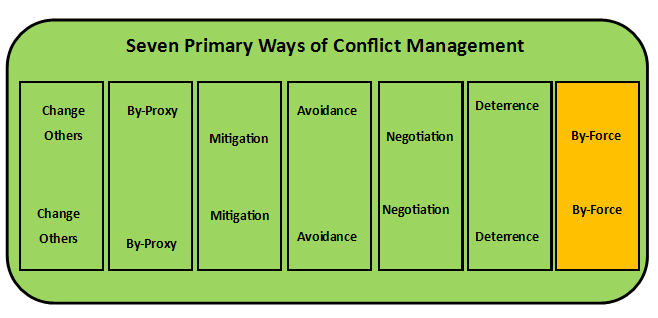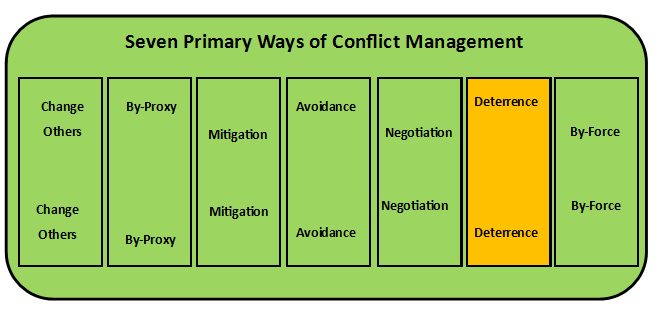Category: Uncategorized
By-Force
When most people think of self-defense, they are usually thinking of the use of By-Force. By-Force is physical self-defense. It is also a form of enforcement. By-Force may be one of the primary ways of self-protection, but it is not reliably effective by itself. The use of By-Force is very closely tied to Deterrence.
While By-Force may be thought of as the last resort or the final option, it should also be thought of as an unreliable option in many situations. While By-Force may succeed spectacularly, it also may fail miserably.
Think of By-Force as a parachute you have packed a few days or many years ago. Maybe it will deploy when you pull the rip-cord or maybe it will not. The longer it has been since you have last used it, the more likely that it will not work as intended. But regardless, you always need to have it available for use.
By-Force is the physical enforcement of your boundaries. It is used when communication has failed. The use of force may be initiated by you pre-emptively, or it may be first applied by your assailant.
The goal of Change Others, Avoidance, Negotiation, and Deterrence is prevention of physical conflict. The goal of By-Force is to stop your assailant’s Intent and/or Means and/or Intent to do you harm with an appropriate physical response(s). An appropriate response is defined legally determined by society. But you are faced with making a decision in the heat of the moment. Therefore, not only is your use of By-Force subject to failure, it is also subject to judgement by society. Failure to use a reasonable amount of force may subject you to criminal penalties and civil lawsuits (a/k/a Over-enforcement).
Once you engage in By-Force, you are in a violent conflict. Prevention has failed. You are now an assault statistic. Invariably, the potential negative consequences of engaging in By-Force are much greater than engaging in Avoidance, Negotiation, and Deterrence. But By-Force may be successful where the others have failed.
In the context physical self-defense, it is common for people to think of it as fighting back against an attacker. In this case, your response to your attacker is going to be combination of instinctive and trained actions heavily influenced by your emotions and prior training and experience. In addition, the effectiveness of your actions will also depend greatly up upon the physical and emotional makeup of your attacker as well as environmental factors.
Many stranger attacks are initiated by relatively lowly motivated attackers. These people are looking for easy victims who will not resist or can be quickly overwhelmed into submission. In this case, the use of By-Force will have a higher chance of success even if the use is technically ineffective. The simple act of resistance may be enough to cause your attacker to disengage. When this happens, By-Force is really a form of communication and a deterrence of a further assault.
But there are also highly motivated attackers who will not give up easily. These people will require a high level use of force response to stop them. Simply resisting is not enough. These people will use tactics and strategies to their advantage. If you are attacked by a highly motivated attacker, the chance of By-Force failing is much greater. Therefore, the best defense against a highly motivated attacker is the use of prevention. You want to avoid them at all costs. You don’t want to rely on By-Force as your only option.
It is also true that many highly motivated attackers are people who know their intended victim. This actually makes sense. It is the perpetrator/victim relationship that creates the high level of motivation to do harm. People who don’t know you don’t care about you. And thus, are usually not highly motivated to do you harm.
There are also many lowly motivated attackers that know their victims. In this case, these attackers use their knowledge of the target as part of their selection process. They attack their victims because they think they will not encounter resistance, particularly the use of By-Force. Therefore, the use of By-Force is more likely to create a successful physical defense.
Most people who come to a self-defense class are looking for “moves” and techniques to use in case of attack. They view assaults only in terms of a physical attack and think the solution is some type of a physical defense. These people fail to take into consideration the other six primary ways of personal safety and how these six ways relate and interact with each other and By-Force. You need to know when it is legal to use By-Force and when it is not legal to use By-Force. You need to know when using by force is likely to make things better and when using By-Force is likely to make things worse.
It is only when By-Force is considered in totality with the other six ways of Change Others, By-Proxy, Mitigation, Avoidance, Negotiation, and Deterrence, and the limitations and risks of By-Force are fully understood that the use of By-Force can become a more viable option for self-defense.
Deterrence
Deterrence is a wide set of strategies and tactics that are designed to discourage someone from attacking you. Avoidance is really a subset of the overall concept of deterrence. Deterrence can be used with both strangers and people you know.
Deterrence focuses on reducing someone’s intent to cause you harm. For example, anything that you do that makes you a harder target has the effect of deterring an attacker looking for an easy victim. Anything you do that has the effect of raising the “cost” and or risk of attacking you is a deterrent.
The following are a few examples of deterrence for runners:
1. Running with other people.
2. Running with a dog.
3. Running in an alert and confident state.
4. Running with a visible weapon.
5. Running in well-lit and well-travelled areas.
6. Running in a powerful manner.
7. Running with a flashlight.
8. Running with a visible whistle or personal alarm.
9. Running a varied route.
10. Running at varied times.
The above is just a few of the many examples of deterrence that are intended to reduce your chance of being targeted. This next category of deterrence is for if you may already have been targeted, but you have not yet been attacked. In this case, the predator is still in the “selection” stage, but you have moved closer to being selected for victimization.
Remember, an attacker must have the intent and means and opportunity in order to attack you. These three concepts are separate, yet also intertwined. Means and opportunity can have an effect on Intent. If someone has the means and opportunity to successfully attack you, that fact may nudge his intent high enough to trigger an attack. If someone has a high intent to attack, then being provided with even minimal means and opportunity may still be enough to launch an attack.
Therefore, deterrence works by lowering intent directly or indirectly through lowering means and/or lowering opportunity. Deterrence has the effect of changing the risk/reward equation such that the risk of attacking you now outweighs the reward. The potential cost is not worth the potential benefit.
The primary method of achieving this result is communicating your undesirability as a victim.
• You are too much trouble to deal with.
• You are someone who will defend yourself physically.
• You are potentially dangerous to the attacker.
• You will be loud and make a fuss.
• You will not be quiet.
• You will not submit.
This message is conveyed through a combination of physical positioning, body language, and verbal declarations and warnings. The message is backed up by your willingness to use force to defend yourself. In order for deterrence to be effective, you must also have the option of using force. It is the knowledge that you will enforce your boundaries that provides the legitimately to deterrence.
Deterrence is also backed up by your willingness to engage in By-Proxy and Mitigation in the event of an attack. In this case, you will report the crime. You will get the police involved, and you will aid in the prosecution of your attacker. In fact, it is more likely that a potential attacker will fear the societal consequences of attacking you than the physical consequences of attacking you.
One reason for that is that he (or she) gets to choose who not to attack. If you are targeted for victimization, it is likely that the attacker has already discounted your ability to successfully fight back. You need to convince him he has made a mistake in his selection process.
Deterrence works by sending a strong message to your threat(s) that he (or she) should not attack or he will suffer the consequences of attacking you. Deterrence is an implicit threat of you using violence in your defense either directly by you or indirectly via By-Proxy. Therefore, the effectiveness of deterrence is dependent on you getting your message across to any and all potential attackers. It a nut shell, your message is “Do NOT mess with me!!!!”
How exactly you achieve this result varies from person to person. It varies from situation to situation. But a common tactic involves a strong use of your voice to establish clear boundaries. The closer a threat is to you, the more direct the message needs to be.
It is important to recognize that any level of deterrence may not be enough to be effective. The threat may choose to attack you anyway. But a low level of deterrence is more likely to be disregarded. When your boundary setting uses Under-enforcement it is likely to result in feelings of contempt and a continuing lack of respect for you.
On the other hand, boundary setting that is perceived as Over-enforcement may result in a backlash against you. In this case, your boundary setting is not effective deterrence. It actually serves the effect of making it more likely you will be attacked. An example of this is the use of naming calling. “Back off!!!!” sends a different message than “Back off you piece of shit!!!!” and “Step back or else!!!”. The first sets a clear boundary. The second is an insult. The third issues a challenge. In order for deterrence to be effective, it must serve the result of making it less likely that the person will want to attack you.
Contributor Map
Loading the interactive map. It takes a number of seconds. Please be patient…
WORLD MAP
[show-map id=’1′]
NOTH AMERICA
[show-map id=’2′]
EUROPE
[show-map id=’3′]
AFRICA
[show-map id=’4′]


